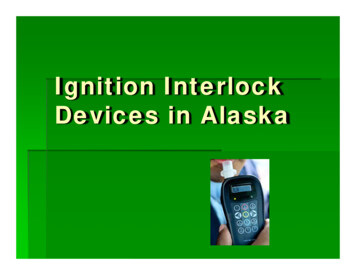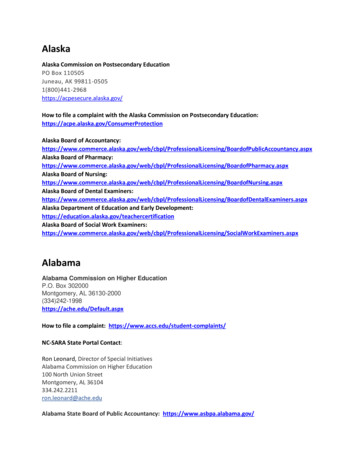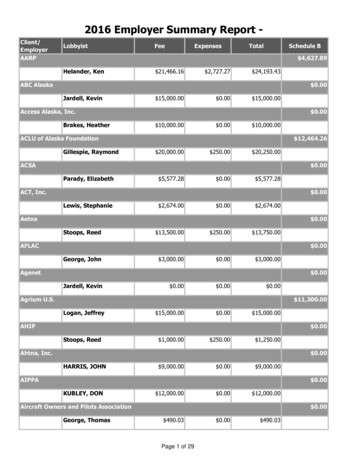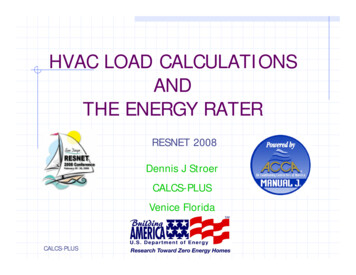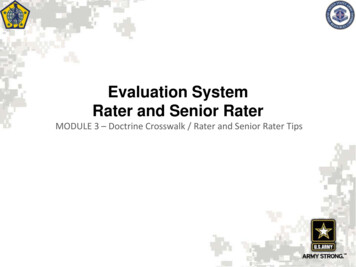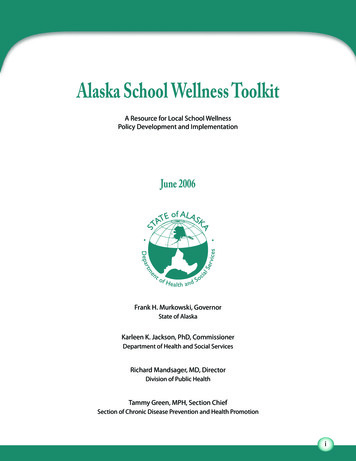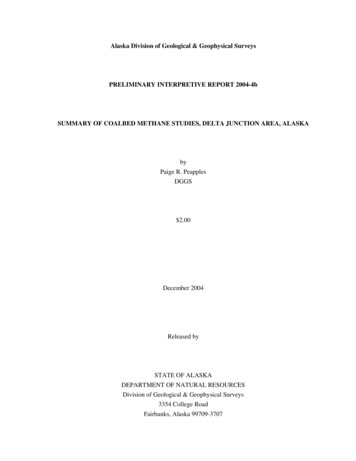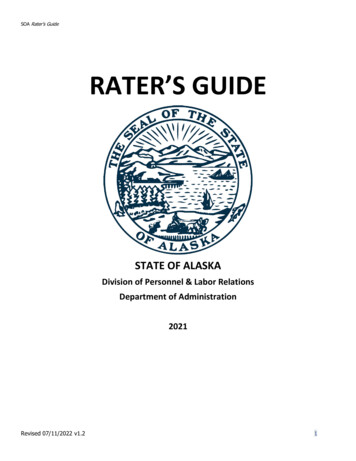
Transcription
SOA Rater’s GuideRATER’S GUIDESTATE OF ALASKADivision of Personnel & Labor RelationsDepartment of Administration2021Revised 07/11/2022 v1.21
SOA Rater’s GuideLimitations on the Use of the Rater’s GuideThe Rater’s Guide does not constitute a contract of employment, nor does it modify or alter any contract, collectivebargaining agreement or statute that governs an employee’s employment with the State. It is subject to change fromtime to time.The Guide does not alter the employing agency’s right to determine, in its sole discretion, whether or not an employeehas successfully completed or will successfully complete his or her probationary period. Evaluations provided to aprobationary employee are provided for the employee’s benefit, not because the employing agency has any obligationto demonstrate that any cause standard has been met in determining that an employee has not or will not successfullycomplete the probationary period.The Rater’s Guide replaces all previous versions of the Rater’s Guide to Performance Appraisals.AuthorityAS 39.25.150(14). Scope of the RulesThe Personnel Rules must provide for the development, maintenance, and use of employee performance records.2 AAC 07.295. Personnel Evaluation(a) the director [of the Division of Personnel & Labor Relations] shall prescribe the nature, form, and frequency ofpersonnel evaluations and may require a personnel evaluation at any time during an employee’s probationary period.(b) the director [of the Division of Personnel & Labor Relations] may take any action necessary to secure the correction ofan evaluation report that is in error.(c) the standards of performance that are established as a basis for personnel evaluation must relate to the duties of theemployee’s position and the job class to which it is allocated.(d) the employee’s supervisor shall discuss each personnel evaluation with the employee, with a goal of assisting theemployee to understand the degree to which the employee is meeting the requirements of the position.(e) the appointing authority shall file employee evaluations with the director. An employee evaluation is open toinspection by the employee or the employee’s designated agent. The evaluations must also be open for inspection, foremployment related considerations, by other officers and employees at the discretion of the director [of the Division ofPersonnel & Labor Relations].The main purpose of the Rater’s Guide is to provide information about the specific provisions regarding personnelevaluations identified in 2 AAC 07.295.Some collective bargaining agreements make reference to performance evaluations or contain specific terms related tothem. Such provisions are subject to change during the negotiation of collective bargaining agreements. It is not theintent of the Rater’s Guide to provide up-to-date information on the terms of a particular collective bargainingagreement. Where references are made to collective bargaining agreements, the purpose is to explain the performanceevaluation process in the broad context of a human resource system which operates within both merit system rules andcollective bargaining.Revised 07/11/2022 v1.22
SOA Rater’s GuideContentsLimitations on the Use of the Rater’s Guide . 2Authority . 2Contents . 3Introduction . 4Overview of the Performance Planning Process . 4Coaching for Performance Throughout the Review Period . 6Observe the employee’s performance . 6Identify performance gaps. 7Provide prompt feedback to the employee. 8Informal review . 9Document observations and feedback . 9Overview of the Performance Evaluation Process . 10What are performance evaluations? . 10How to Prepare for a Performance Evaluation. 11Determine the Type of Evaluation to be Written . 11Employee Accomplishment Statement . 12Writing the Evaluation . 12Conducting Evaluation Meetings . 15Develop Plan for Future Performance . 16Summary . 18Appendix A - Rating Scale . 19Appendix B – Considerations and Cautions . 20Appendix C – Reason for Evaluation . 21Appendix D - Examples of Roles and Responsibilities . 22Revised 07/11/2022 v1.23
SOA Rater’s GuideIntroductionThe performance management process is an effective management tool for establishing and maintaining avital communication link between supervisor and employee and improving employee job performance andbehaviors. Performance management is a collaboration between employees and their supervisors—both havean essential role to play. The performance management process is a recurring cycle of setting goals andexpectations, reviewing performance, and improving performance where necessary. Of course, one cannotevaluate performance if clear metrics do not exist.Performance evaluations are required, but that is not the main reason we do them. Instead, performanceevaluations are one of the primary tools for managers to use to cultivate employees in order to meet strategicorganizational goals.Note: While this guide refers to supervisors, it includes lead positions responsible for writing and contributingto performance evaluations.For additional training on all subject areas listed in this guide please refer to the Performance ManagementCurriculum in AspireAlaska.The Performance Management & Learning and Development (PMLD) form can be found on the Division ofPersonnel & Labor Relations website. Variations of this form will not be accepted unless authorized by theDOP&LR Director.Overview of the Performance Planning ProcessPerformance planning for the upcoming review period provides an opportunity for supervisors and employeesto work together to clarify and set performance expectations, create SMART goals for the future, and identifylearning and development activities that will provide growth opportunities for the year ahead. ThePerformance Management & Learning and Development (PMLD) form provides space to define each of theseareas for the upcoming rating period. These fields should be reviewed and updated on the PMLD form eachreview period.While it is ultimately supervisors who will determine whether an employee has met (or not met) expectationsat the end of the review cycle, these plans should be developed collaboratively at the beginning of eachreview cycle. For new employees, or for employee’s changing positions, performance planning should becompleted as soon as possible after the employee is hired into their position.Below is a summary of employee and supervisor responsibilities to ensure success during the performanceplanning process.1. Define Performance ExpectationsEmployees should work with their supervisors to identify performance and behavioral expectations forsomeone in their position based on their official Position Description, which can be found in the OnlinePosition Description (OPD) system. Performance Expectations are behavioral indicators with measurableresults that define the standard for what “meets expectations.” If an employee is meeting their performanceexpectations, they can objectively be determined to be performing well. If not, this signals clear areas forimprovement.These performance expectations are then added to the Performance Expectations section of the PerformanceManagement & Learning and Development (PMLD) plan.Revised 07/11/2022 v1.24
SOA Rater’s GuidePerformance expectations should be: Observable (an action or behavior you can see) Job-related (tied to their job description) Results-oriented (centered on a particular outcome)Examples for Accounting Technician 2: Documents purchasing and invoicing within seven days. Demonstrates appropriate use of coding, including chart of account year and fiscal period codes. Analyzes the coding on each RSA to determine recommended billing cycle.At the end of your planned review cycle, the supervisor will determine whether the employee met theseexpectations. They have two options on the form: Met Expectations Did Not Meet Expectations2. Set SMART performance goals.Employees will work with their supervisor to define performance goals for the year (i.e., what you should aimto accomplish over the upcoming year based on your section/division/department’s strategic objectives) andrecord this information in the SMART Goals section of the Performance Management & Learning andDevelopment (PMLD) plan. Performance goals should be “S.M.A.R.T.,” so check that they are: Specific: The goal should be narrowly focused and empower the employee to plan out their yearand set milestones. Measurable: The goal should have a quantifiable component (e.g., length of time, dollar amount). Attainable: The plan should have a measurable part (e.g., length of time, dollar amount). Relevant: The goal should be relevant to the employee’s work and the department or division’sstrategic priorities. Time-Bound: The plan should make it clear when the employee is meant to have met theirobjective.Examples for Accounting Technician 2: Serve on one interview panel for a technical level position within the Department by September 30,2021. Develop an instructions worksheet on RSA functions to provide cross-training to one otherAccounting Technician 2 by June 30, 2021.At the end of your planned review cycle, the supervisor will determine whether the employee met these goals.They have two options on the form: Met Goal Did Not Meet GoalRevised 07/11/2022 v1.25
SOA Rater’s Guide3. Outline a learning and development planThe employee’s learning and development plan should be tailored to their specific interests and goals andshould identify growth opportunities that directly align with the organization's objectives. There are four stepsto constructing a clear development plan that will help an employee reach their development goals.Employees should ask themselves: how would I like to learn and grow this year? What skills do I need todevelop? Employees should record this information to discuss with their supervisor and make sure these ideasget added to the Performance Management & Learning and Development (PMLD) plan.Supervisors should provide opportunities for training and stretch assignments that help employees meet theircurrent learning and development goals. For example, an employee has expressed interest in becoming asupervisor in the future. The current supervisor could offer to let that employee participate in a hiring panel asa stretch assignment.4. Check in throughout the yearCreate a plan to keep track of progress on the Performance Management & Learning and Development(PMLD) form throughout the year. Supervisors should offer frequent, informal feedback throughout the year,and coach employees through their challenges to keep them on track and help them improve.Employees should engage in regular check-ins with their supervisor and be sure to clarify information whenneeded, and keep their supervisor appraised of any questions, problems, concerns etc. that may arise.Coaching for Performance Throughout the Review PeriodCommunicating standards and expectations orally and in writing to allow an employee the opportunity to askfor clarification or discussion of the criteria is essential. The greater the mutual understanding about expectedjob performance between you and your employee, the better. Employees who understand what is expectedare more likely to deliver acceptable performance; the sooner the employee is aware of the standards, thegreater chance the employee can acceptably perform the work from the beginning.In an effective organization, job performance is continuously coached. Coaching is the process of lettingemployees know that what they do matters.Although every supervisor’s approach to coaching an employee’s performance is unique, the primary methodshould include these steps:1. Observe the employee’s performance2. Identify performance gaps3. Provide timely feedback to the employee4. Document observations and feedbackObserve the employee’s performanceObservations can be planned or spontaneous. Supervisors should communicate with employees ahead of timeabout the various ways performance could be monitored. The following are some ways to observeperformance. Self-Report: Establish a performance expectation requiring an employee to provide regular status reportson his or her performance.Revised 07/11/2022 v1.26
SOA Rater’s Guide Meetings: Schedule regular meetings to stay informed about the employee’s performance, such as statusmeetings on a long-term project. Feedback from third parties: Lead workers, coworkers, and customers may provide feedback about anemployee’s job performance.Please note: The accuracy of this kind of feedback should be verified. Examples: Collect copies of written documentation or samples of an employee’s work product. Audits/sampling: Review a portion or percentage of an employee’s work product. Spot checks: Routinely review the employee’s work or do brief check-ins or phone calls. Management by walking around: Walk through the employee’s work area or schedule “sit-ins” to observejob performance.Identify performance gapsPerformance gaps are defined as the difference between the employee’s actual performance and expectedperformance based on the performance expectations established in the Performance Planning Session.Once the performance gap is identified, work with the employee, if possible, to identify the reason and causeto then work on a plan for how to meet that expectation.Here are some example causes for Performance Gaps: Competency: This usually occurs with a new or probationary employee where they have not previouslydemonstrated the ability to meet the expectation. In this case, supervisors need to help build up theemployee’s knowledge, skills, or ability through training, job aids, and/or peer mentoring. Motivation: This can occur when an employee has demonstrated the ability to meet the expectation oreven exceed the expectation, but recently they have not been meeting that expectation. This could bedue to a lack of motivation. It is important for supervisors to provide consistent feedback to theiremployees to help motivate them to achieve more. If the employee is not recognized for the good jobthey are doing, it can affect their motivation long term. Environmental: This can also occur for a multitude of reasons but is often outside of the employee’sdirect control. Things like a slow computer that won’t run the latest software, lack of data necessary tocomplete tasks, and/or conflicting information. This can be solved by working with whoever needs tobe reached to fix the underlying issue.The following is an example where an Accounting Technician 2 is not meeting one of the performanceexpectations identified on their Performance Management & Learning and Development (PMLD) form andsome of the reasons and potential solutions that can be explored.Performance Expectation: Documents purchasing and invoicing within seven days.Performance Gap: Employee is not documenting purchasing and invoicing within seven days.CauseExample ReasonExample SolutionCompetencyThe Accounting Technician 2 is a newemployee, and they lack the necessaryskills needed to document the purchasingand invoicing within seven days.Help provide training for the employee toincrease their competency. That couldmean sitting with another accountingRevised 07/11/2022 v1.27
SOA Rater’s Guidetechnician to see how they process anddocument the purchasing and invoicing.MotivationThe Accounting Technician 2 hasdemonstrated the ability to meet theexpectation, but recently they are nolonger meeting that expectation becausethey do not know why things have to bedocumented within seven days.Have a discussion with the employee andmake sure that they understand why thatperformance expectation was set withthat timeframe. It might also require someadditional coaching to help improveemployee motivation.If this is a brand-new position, then youcould consider whether a change needs tobe made to the expectation as well if it ishindering other work.EnvironmentalThe Accounting Technician 2 hascontinually experienced issues with thesoftware that keeps causing delays fordocumenting the purchasing and invoicingwithin seven days.Work with the Admin Staff and OIT tofigure out if there are any computerupgrades or software upgrades that needto be made to the employee’s computer. Ifthe changes will take time or cannot bemade right away, you could considerupdating the Performance Expectations.The proper solution to the performance gap depends on the reason(s). Once causes have been identified, thensolutions can be worked out with the employee to help them meet all expectations.Provide prompt feedback to the employeeFeedback is a valuable tool that supervisors can use to ensure clear, consistent communication about anemployee’s performance. The most effective feedback occurs when given promptly after an occasion arisesthat warrants it.Feedback is an essential component of coaching; especially when the feedback is expressed positively and isspecific to defined performance expectations. When giving feedback: Avoid being vague or subjective. Show the employee how their performance is or is not meeting the expectations and standards. Make it individualized—do not compare to other staff but to the bar or established metric for success.Praise: When praise is warranted for improvement, prompt feedback means that the quicker positivefeedback is provided to the employee, the sooner the excellent work is repeated. Encourage good work by notletting it go unnoticed, and by being specific.For example, rather than telling the employee vaguely that they “did a great job with the year-end order”,provide objective, factual job-related feedback and/or examples; such as, “I liked your assistance in helpingme with our year-end orders by coming up with that spreadsheet to track the orders and taking the lead incoordinating with the vendors and our accounting staff.”Correction: When correction in performance is warranted, prompt feedback means that the quicker theemployee is aware of the need for correction, the sooner they can correct it and improve. Correcting feedbackRevised 07/11/2022 v1.28
SOA Rater’s Guideshould be given in private. Start by discussing what you’ve observed with the employee and then asking howthey could have done better. If the employee identifies a better way to perform, provide positive feedback to encourage them. If the employee cannot determine a better way, make your feedback positive and your solutionpractical.Challenge: When an employee gets off-track in meeting standards or expectations, challenge their behavior.Like correcting feedback, challenging feedback should be given in private. Start by stating what poorperformance you have observed and listen to their response. Remind them of the performance standard orexpectation. Ask the employee for a specific solution and then agree together on the solution. Ensure theemployee has implemented the solution by follow-up observation.Asking employees to evaluate their performance regularly can help determine how well you communicate andcoach the employee.Informal reviewIn contrast with the formal review period, the informal review is based on day-to-day contacts betweensupervisors and employees where progress is checked, and performance is discussed. During these informalreviews, plans for correcting performance deficiencies or for developing performance may be made, andperformance should be monitored for progress in meeting the plans. Inaccurate or inadequate performanceexpectations may be identified and corrected during the informal review process.The ongoing informal review is an integral part of the performance appraisal process. When these casualreviews are documented and relied upon in the preparation of the formal evaluation report, the finalevaluation report is much like a summary of the informal reviews.Throughout the entire appraisal period, show the employee how the employee’s performance is or is notmeeting the expectations and standards. Discuss the results and work with the employee to identify solutions,if needed.There should be no surprises to the employee in the performance evaluation report, as it should never be thefirst time the employee learns they are not meeting expectations and standards.If after implementing solutions and/or feedback with a timeframe for improvement the employee’sperformance is still not meeting expectations, contact your departmental HR office for assistance with aPerformance Improvement Plan (PIP) or other coaching tools.Document observations and feedbackKeeping notes about performance and collecting other documentation throughout the rating period is a goodhabit for supervisors. All coaching and informal review activities should be documented and kept in a securelocation. They must be available for the employee’s review upon request, although you may also copy theemployee when you place it in their file. Some collective bargaining agreements require them to be providedto the employee at the time it is originated.Documentation may include: Performance planning documentation, including performance gap identification Notes on feedback and informal performance reviews Records of discussions related to work performanceRevised 07/11/2022 v1.29
SOA Rater’s Guide Activity, audit reports Specific instances of work that falls short of the standard or exceeds the standard (redact confidentialinformation such as client names, SSN, etc. OR if the document is protected by law or policy, referencedocument but do not maintain in the file) Commendations (e.g., letters of appreciation, customer feedback) or substantiated (not hearsay orsupposition) critical comments received about an employee’s work. Special activities or awards the employee received that reflect on their or the organization’sperformance. Training records Appropriate attendance reports (without medical information)Overview of the Performance Evaluation ProcessWhat are performance evaluations?Performance evaluations are formal meetings occurring at specific time intervals (typically annual) heldbetween an employee and their supervisor. These meetings are required by the organization, and differentfrom one-on-one coaching sessions or informal feedback discussions.Supervisors typically come into performance evaluations prepared with data on an employees’ results andbehaviors to discuss how well they are doing on the job — or “the degree to which the employee is meetingthe requirements of the position,” as stated in the State of Alaska’s Personnel Rules. Formal performancereviews are to be conducted annually to discuss what has gone well and/or where employees need toimprove. Performance evaluations may also be conducted for additional reasons as listed a little later in thisguide.The formal performance evaluation process gives employees and their supervisors a formal opportunity todiscuss where performance is strong, where it should be improved, and plan for the next year.Performance evaluations are directly linked to:1. Strategic Planning: Long-term workforce planning uses performance management results to assess theworkforce's effectiveness and whether or not the organization is hiring and retaining the right people.2. Recognition: Visible appreciation leads to higher employee engagement and job satisfaction.Performance evaluations commemorate the work that employees conduct throughout the year,formally acknowledging their achievements.Revised 07/11/2022 v1.210
SOA Rater’s Guide3. Learning and Development: At the end of the performance evaluation, employees and supervisorsdevelop a plan for further growth and development.4. Workforce Planning: Performance evaluations provide data necessary to make merit-based workforceplanning decisions. Supervisors can use this information to leverage each employee's strengths andalign the right people to the most valuable work.When clear performance expectations, goals, and development activities have been established during theplanning period, and coaching conversations have been held throughout the year, the performance evaluationprocess should be straightforward.How to Prepare for a Performance EvaluationThe performance appraisal process is cyclical. Supervisors continuously assign work, communicateperformance expectations, coach performance, and evaluate how well the work has been done. Change in anyone of these steps may trigger change or a need for action in another.Some steps in the performance appraisal process, such as coaching performance, are often performed ad hocin daily interactions or the routine review of work products. Other actions, such as reporting performance orclarifying job duties, are more typically done according to a defined process or schedule, such as an evaluationwritten at the end of a review cycle or a position description (PD) updated in preparation for recruitment.Determine the Type of Evaluation to be WrittenBelow are the most common reasons for preparing a performance evaluation for a State of Alaska classifiedemployee (Note: Specific requirements are subject to the applicable collective bargaining agreementprovisions).Required: The following evaluations are required by statute, regulation, contract or other authority and mustbe completed.InterimProbationary employees are due an interim performance evaluation completed halfwaythrough their probationary period. Failure to provide the interim performanceevaluation may affect a department’s ability to separate a probationary employee. Seethe applicable collective bargaining agreement.Completion ofprobationEmployees are due a performance evaluation documenting successful completion of theprobationary period. This applies specifically to the General Government, Supervisory,Correctional Officer, Public Safety, AVTEC and Confidential bargaining units.AnnualPermanent employees are due a written performance evaluation annually. This appliesspecifically to the General Government, Supervisory, Correctional Officer, Public Safety,LTC, AVTEC and Confidential bargaining units. Pay increments are paid only when anannual evaluation recommending such is finalized. For employees in the Supervisorybargaining unit, an evaluation with an overall rating of mid-acceptable or higher isrequired for a merit increase to be granted.Separation from An employee, including a nonpermanent one, is due a written performance evaluationstate servicewhen they leave state service.Revised 07/11/2022 v1.211
SOA Rater’s GuideRecommended: Evaluation types described in this section serve useful performance management purposesand are strongly recommended.Change ofsupervisorA performance evaluation should be written when there is a change of supervisor.TransferA performance evaluation should be written when an employee transfers to anotherdepartment or position.PerformanceDrivenA performance evaluation should be written when an employee’s performancebecomes less than mid acceptable or when performance improves to mid acceptable.HR staff can provide agency guidelines.SeasonalA performance evaluation should be written when an employee goes on seasonal leavewithout pay after seasonal employment of more than 30 days.Discretionary: Evaluation types described in this section are n
The Rater's Guide replaces all previous versions of the Rater's Guide to Performance Appraisals. Authority AS 39.25.150(14). Scope of the Rules . Performance Expectations are behavioral indicators with measurable results that define the standard for what "meets expectations." If an employee is meeting their performance expectations .
